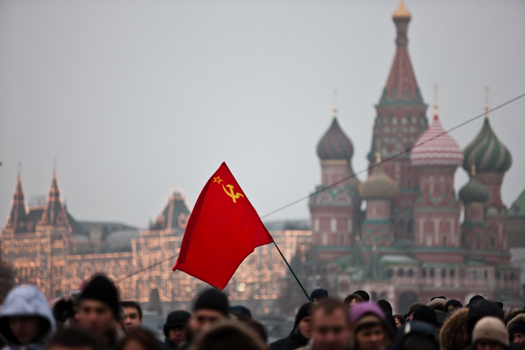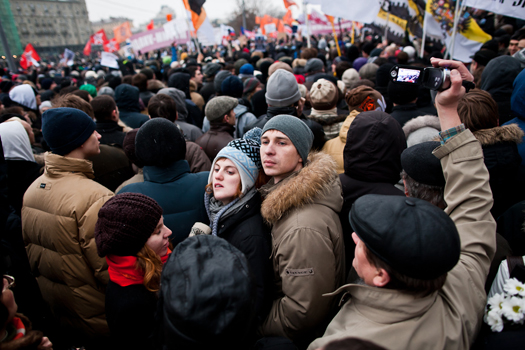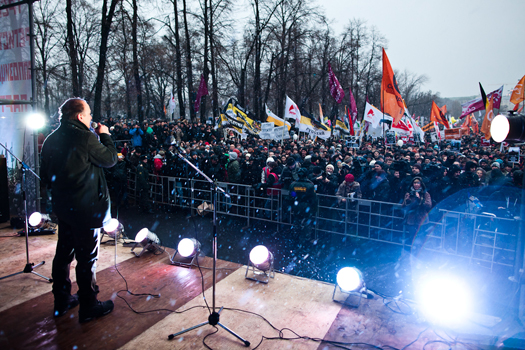
Protesters cross the bridge from Red Square on the way to Bolotnaya. (Max Avdeev)
The week before Saturday’s protest, Moscow was on high alert. Military helicopters circled the city at all hours, and armored personnel carriers prowled the capital’s highways. Social networking sites were flooded with warnings against “provocations” and instructions on what to do if detained by the police. Hundreds of protesters had been arrested, with some sentenced to fifteen days in jail, at demonstrations on Monday and Tuesday.
Not knowing what to expect and wanting to avoid being in the middle of a potentially volatile crowd, my friends and I started out a bit late. Bolotnaya Square, where the demonstration was being held, was right across the street from my friends’ apartment, but the underground crossing had been blocked by metal barricades and riot police. Four or five boxy young men in gray fatigues and bulletproof vests were guarding the entrance. They turned out to be friendlier than expected: a woman in her sixties, with a white ribbon (a symbol of protest against election fraud) pinned to her coat, was sneaking mandarins and what looked like cigarettes into the officers’ front pockets. A minute later, she disappeared into the underpass.
We weren’t eager to test the indulgence of the police and set out toward the protest the more circuitous way. Bolotnaya Square—which literally means Swamp Square (a cynical joke by the government, which chose the location, some claimed)—is situated in the middle of an island in downtown Moscow. We walked down the south embankment, taking pictures in front of the Kremlin and consulting with passersby as to the best route. A side street to the square had been blocked off by police cars, and no one seemed to know if any passageways to Bolotnaya had been left open. As we walked, we spotted several unmarked cars with uniformed police officers inside.
We could see crowds with flags marching on the bridge in front of us; these were the protesters who started out at Revolution Square and who had just marched through the Red Square on the way to Bolotnaya. The human flow was ceaseless. We saw thousands of people walk by as we approached. Under the bridge, tucked neatly out of sight, a veritable armada of law enforcement vehicles was parked. On the bridge itself a row of police cars and officers lined the curb to prevent protesters from leaving the sidewalk. Some police officers looked nervous, others focused. One petted his rubber baton continuously.

Nervous soldiers keep protesters from blocking bridge traffic. (Max Avdeev)
We had gotten up to the bridge just as a large group of nationalists, carrying the black and yellow Imperial Russian flag, was heading to the square. To avoid their company, we waited for several minutes, as the flags kept coming. Finally, there was a break in the nationalist ranks, and we seized the opportunity to get closer to the square itself. Riot police—vigilant but calm—were everywhere. We passed an elderly woman standing quietly at a street corner, with a sign that said: “Give us free elections! Fire Churov! Freedom for the prisoners of conscience!” Several people stopped to photograph her. Almost everyone was taking photographs; others were busy with their smart phones, Tweeting, posting, checking in. Cell phone service in the immediate vicinity of the square would crash a half-hour later. Camera crews were omnipresent: in the crowd, on balconies, on roofs, on a parked fire truck.

Protesters crowd the bridge from the Kremlin. Police would later close the footpaths, citing fears the bridge would collapse. (Max Avdeev)
Most protesters were between twenty and fifty years old. There were few teenagers, since the Moscow government had declared December 10 a mandatory school day earlier that week. Bolotnaya Square, usually a favorite location for goth youth, was filled to the brim with people, and the crowd spilled over three bridges and two embankments. There were protesters as far as the eye could see, and lots of flags. For some reason, the Communist and nationalist ones stood out the most, although I later spotted dozens of people holding signs—many displaying a wry sense of humor—that took aim at Putin’s party. A large banner reading—“Crooks and thieves, give back the elections!”—had been suspended from one bridge.

A banner calls for the release of Alexey Navalny—the blogger and opposition activist who coined the phrase ‘Party of Crooks and Thieves,’ in reference to United Russia and was sentenced to fifteen days in prison following Monday’s protest. (Vladimir Kopylov)
Less than an hour into the demonstration, Bolotnaya was full and fully sealed off. The police were not letting any more people onto the one small bridge that led to the square. Later in the evening it would be reported that law enforcement worried the bridge would collapse from the sheer weight of the protesters standing on it. A single police boat floated on the murky Moscow River.
We walked farther up the riverbank. The parapet was too high for us to see the square, and a fashionable woman, holding a Louis Vuitton bag, asked her six-year-old daughter to move a little closer to her so we could climb up. “Where did you get the white ribbons, girls?” she asked, sounding slightly envious. This scene—an upper-middle class woman, dressed to the nines, bringing her young daughter to a protest in Moscow—was unfathomable even a week ago. But here they were, huddling closer and closer together so that more people could get up on the parapet and see. And they were hardly an exception. The crowd on the Kadashevskaya embankment, south of the square, looked pretty much entirely middle-class.

Protesters crowd the stage in Bolotnaya Square. (Max Avdeev)
The chants were hard to hear. I could only make out “Re-elections!” and “Putin is a thief!” Those were followed by applause on the square, the riverbank, and the bridges. But what was being said, somehow, seemed to matter less than the sheer number of protesters present. This was not, after all, a meeting of the politically like-minded, but rather a gathering of all those opposed to election fraud—and this meant that what was being said on stage varied wildly. But here we were, tens of thousands of us. Moscow had not seen a protest so large since the 1990s, and this kind of turnout was unimaginable even on Monday. Everyone seemed astounded at the crowd, and there was a general sense of amazed disbelief — at the number of people who showed up, at the calmness of the police — wafting through the crowd. The mood was festive.
But the day was getting increasingly chilly and gray. Around four in the afternoon, nationalist factions on the square launched several smoke bombs. A flying camera that had been hovering over the protest fleeted away. “That’s what’s going to be in the news tomorrow,” a friend murmured disappointedly. People began to leave and the demonstration ended shortly thereafter, around five, with demands put forth to the government and the promise to come back and protest in a week, and then again in two.

Police patrol the edges of Bolotnaya Square as protesters disperse to surrounding taverns and cafes. (Max Avdeev)
As we walked toward dinner, we saw a young man hand a passerby a bouquet of white flowers, a symbol of opposition to election fraud. “A historic photograph!” the young man’s friend shouted while examining a picture of the scene on his digital camera. In the warmth of a restaurant in the trendy art district, just a short walk from the square, we watched as scores and scores of protesters poured in, ordering food and drink. The words “revolution,” “protest,” “crowds” could be heard at every table.
On Sunday morning, among hundreds of pictures from the demonstration, a blurry photograph of the square at night appeared on my Facebook feed. The caption read, “Everything is calm on Bolotnaya, but across the street they are partying as always. People are drinking as though nothing has happened.”






